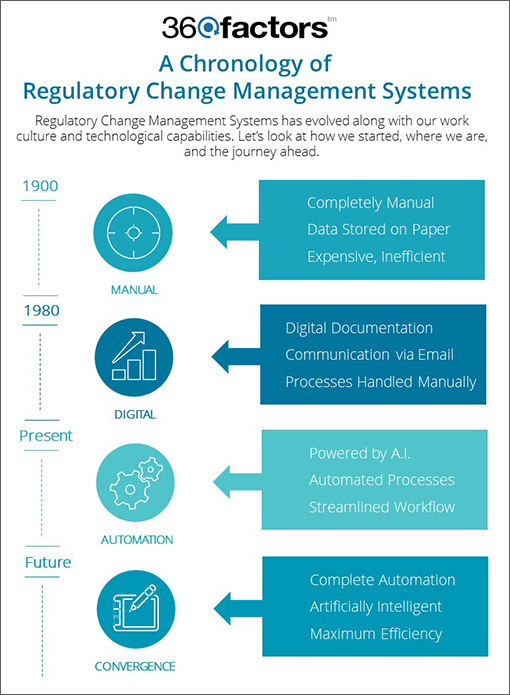Home/ Blog / The Future of Regulatory Change Management
We are living in a time of immense technological growth. The information age has enabled advances in technologies that exponentially increase productivity and efficiencies. Regulatory change management (RCM) systems have benefited greatly from these technological leaps and have evolved along with technology.
A Chronology of Regulatory Change Management Solutions
Every major change in regulatory change management systems has come with a new age of information technology. We can create a timeline of the four different eras of RCM systems:
- Manual (1900 – 1980)
- Digital (1980 – Present)
- Automation (Present – Future)
- Convergence (Future)
Manual (1900 – 1980)
1887 marks the year that businesses were first regulated by the federal government when it passed the Interstate Commerce Act. Regulatory change management soon emerged as an expertise domain. The regulatory change management solutions of this era were:
Completely manual
There was no automation. All business processes had to be managed manually, which resulted in a lot of work and calculations being done manually. In these days being a calculator was a career – large enterprises had whole departments of people only tasked with crunching numbers.
Paper based
All information was stored on paper. As you can imagine, this added many constraints to the RCM system. Employees had to manually locate and verify every piece of information.
Costly and inefficient
As one can imagine, these systems were very expensive yet inefficient. Expensive because they required a substantial amount of human resources and inefficient because there were no tools to speed up the processes.
Digital (1980-Present)

While information technology had begun to influence the world of business a few decades before 1980, it took I.T. a little more time to reach RCM systems, and it is easy to see why. The first few computers were powerful enough to crunch numbers, thus they were being used in accounting and other departments primarily dealing with numbers and databases. However, there wasn’t enough computing power for other business uses at that time. Once word processors and spreadsheet software came into the market, information technology began to be adopted across organizations in almost all industries.
Digital documentation
The most significant change brought on by this era is digital documentation. Digital documents proved to be very beneficial for the business world. It allowed organizations to systematically store, share, and edit documents in a way that was simply not possible before.
Communication via email
Being able to instantly communicate via email also proved to be a gamechanger. It allowed organizations to collaborate with much higher efficiency and share the data required instantaneously.
Processes handled manually
While the documents and data were digital, the processes of regulatory change management were still largely being handled manually. There were a few bespoke regulatory change management systems in the market, but they were prohibitively expensive and only had very basic functionality.
Automation (Present-Future)
Automation is our current era. The regulatory change management systems of today, like Predict360, use machine learning and A.I. technologies to deliver improved regulatory change management results while using fewer resources. It is important to remember that A.I. has just been introduced in the past few years. The use of neural computing and machine language to create intelligent solutions is revolutionary and is leading to exponentially growing computing capabilities.
Powered by A.I.
Smarter RCM systems today, such as Predict360, incorporate A.I. and machine learning technologies that enable greater speed and intelligence. They understand the way regulatory change needs to be managed and make it easier for regulatory experts to identify and implement changes.
Automated processes
The RCM systems of today introduce robotic process automation to regulatory change. They completely automate manual processes and automate large parts of other processes. While we still need people for higher level strategies, many simple tasks can be accomplished by software solutions.
Streamlined workflow
A major focus for modern RCM systems has been the streamlining of workflows. RCM systems focus on enabling collaboration throughout the organization and make it easier to access regulatory data. This allows regulatory experts to work with exponentially higher productivity.
%%POST-CONTENT-DEMO-BANNER%%
Convergence
The advent of artificial intelligence will mean a convergence of technologies and solutions, allowing us to fully automate not just regulatory change management, but whole businesses. That is where A.I. will eventually lead us. The growth of A.I. will be similar to the growth we saw in information technology. Computers and networking both existed in the 80s and were being used in a limited capability. However, it wasn’t until the internet became available for everyone nearing the end of the 90s and the beginning of 2000s that IT truly changed the way we do everything. A.I. is advancing to similarly change not just the way our businesses operate but the way we live as well.
Complete Automation
This era will be marked by completely autonomous systems working together. This means that the regulatory change management system will not be the only automated A.I. system – it will be collaborating with GRC systems, the regulatory bodies, and administrative systems automatically, without very little human intervention.
Building towards the future
Regulatory change management systems are, right now, delivering efficient and streamlined solutions only made possible through A.I. powered technology. As A.I. develops further, the efficiency and productivity of RCM systems will also increase.
Focusing on the present
A.I. is easily one of the most exciting technological developments on the horizon, which is why businesses are now investing in A.I. powered solutions like Predict360 to reap the benefits. Such solutions use bleeding edge technology to increase productivity and accuracy while lowering costs. Want to see how an RCM system will benefit your organization? Get in touch with the 360factors team to find out.
Request a Demo
Complete the form below and our business team will be in touch to schedule a product demo.
By clicking ‘SUBMIT’ you agree to our Privacy Policy.



